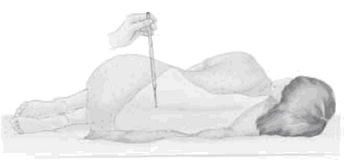Solution-Human brain and spinal cord
The human brain and spinal cord are immersed in the cerebrospinal fluid. The fluid is normally continuous between the cranial and spinal cavities. It normally exerts a pressure of 100 to 200 mm of H2O above the prevailing atmospheric pressure. In medical work pressures are often measured in units of millimeters of H2O because body fluids, including the cerebrospinal fluid, typically have the same density as water. The pressure of the cerebrospinal fluid can be measured by means of a spinal tap, as illustrated in Figure. A hollow tube is inserted into the spinal column, and the height to which the fluid rises is observed. If the fluid rises to a height of 160 mm, we write its gauge pressure as 160 mm H2O.
(a) Express this pressure in Pascals, in atmospheres, and in millimeters of mercury.
(b) Sometimes it is necessary to determine if an accident victim has suffered a crushed vertebra that is blocking flow of the cerebrospinal fluid in the spinal column. In other cases a physician may suspect a tumor or other growth is blocking the spinal column and inhibiting flow of cerebrospinal fluid. Such conditions can be investigated by means of the Queckensted test. In this procedure, the veins in the patient’s neck are compressed, to make the blood pressure rise in the brain. The increase in pressure in the blood vessels is transmitted to the cerebrospinal fluid. What should be the normal effect on the height of the fluid in the spinal tap?
(c) Suppose that compressing the veins had no effect on the fluid level. What might account for this?

